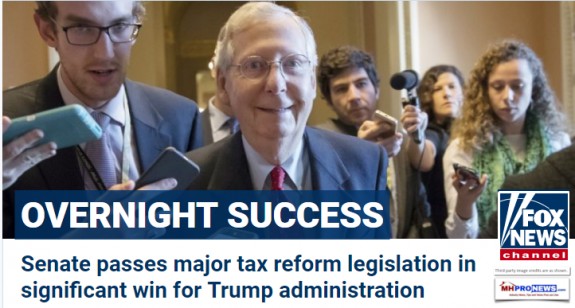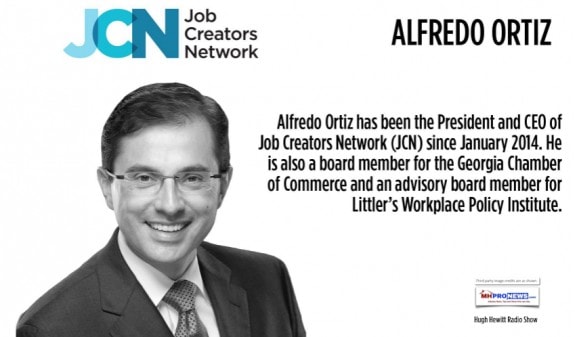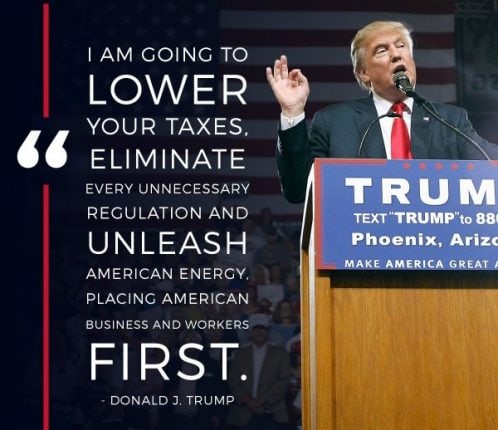
Higher wages. More economic output. More opportunities.
All of these would be good things for manufactured housing, and it goes to the heart of what the White House Pressroom has told the Daily Business News is at the heart of what they say this bill that passed early this morning is about.
That it is time to “fix America’s self-destructive tax code.”
Democrats say it’s a “middle class con job,” per the right-of-center Wall Street Journal.
Fox and the Wall Street Journal said it was an “epic blunder” for Democrats to think that this won’t hurt them, rather than Republicans, in the 2018 midterms.
From left-of-center CNBC this report will outline changes to the bill that got 51 of 52 GOP Senators to sign on.
ICYMI – for those not familiar with the “Full Measure,” ‘left-right’ media tendency chart, please click here.
For left-of-center Bloomberg, Professor DeLong says the tax cuts/reforms package has a 70 percent chance of becoming law. If so, that would give the President his first big legislative win, and coupled with his other promises kept to-date, and could bode well for the GOP in the 2018 mid-terms.
The lone Republican holdout from their 52 Senate members?
The retiring Bob Corker of TN, who was considered at one point last year for being President Trump’s running mate.

Ortiz on the Historic Bill
Alfredo Ortiz is President and CEO of the Job Creators Network, self-described as “a non-partisan organization founded by entrepreneurs.”
Ortiz, writing for right-of-center Fox News, said, “Tax reform is on track and Democrats want to derail it. Don’t believe these myths about the Senate’s bill”
“Democrats are desperate to derail long-overdue tax relief that is heading to the Senate floor for a vote this week – even if by doing so they take money from the pockets of their own constituents,” Ortiz asserted.
“There are no good arguments against allowing hardworking Americans to keep more of their money,” the Job Creator’s CEO said. “But that hasn’t stopped Democrats, who are intent on denying President Trump a victory at any cost – including lying about the Senate tax bill’s impact in an attempt to block its passage.”
“This deceit was on full display at a CNN Town Hall debate this week, where career politicians Sens. Bernie Sanders of Vermont and Maria Cantwell of Washington state leaned on shopworn Democratic talking points as the basis for…their opposition to the tax bill.”
Ortiz then laid out 5 myth-busters, to debunking claims “making the rounds among Democrats and their media allies.”
MYTH 1: The tax bill is a tax increase on the middle class.
Cantwell: “Raising taxes on the middle class is wrong, and that’s what this bill does.”
“Recognizing the popularity of a middle-class tax cut, Democrats are trying to use the Bizarro-world argument that the tax cut bill is actually a tax increase. They cite a Tax Policy Center report claiming the bill would raise taxes on 87 million middle-class families,” said the Job Creator CEO.
“What the Democrats don’t mention is that the Tax Policy Center is a project of the left-wing Brookings Institution and Urban Institute, funded by donors like George Soros who want to disrupt President Trump’s agenda by any means necessary.”
Soros is the Hungarian born left-wing billionaire, who recently gave billions to fund left wing-causes, many of which oppose the Trump agenda. For more on that, see the report below.
“You Made Me, Promises, Promises…” Historic Iranian, American Lessons in Freedom
“The Tax Policy Center can only arrive at this eyebrow-raising conclusion by making the unrealistic assumption that the tax cuts would expire after 10 years,” said Ortiz.
“In reality, the tax bill would provide significant relief for the middle class by doing the following: doubling the income threshold under which families pay no taxes at all to $24,000; doubling the child tax credit to $2,000; and eliminating the 15 percent tax rate in favor of an expanded 12 percent rate, among other provisions,” per Ortiz.
He said that the above changes would “save ordinary families thousands of dollars a year.”
MYTH 2: The majority of the tax bill’s benefits go to the top 1 percent of earners.
Sen. Sanders: “60 percent of the tax benefits in the Republican plan would go to the top 1 percent.”
“Democrats are trying to distract from the bill’s middle-class tax relief by claiming most of the benefits go to the super-rich. But in reality, the bill is targeted at the middle class,” stated Ortiz.
Besides, who’s money is it anyway? What years of repeated claims from those who love big government and socialistic policies often overlook, is that money is earned by citizens and guest workers. Yet, many in Washington and beyond want to treat that privately earned money as if it was up to technocrats to decide how much of your own money you get to keep.
Influencing the Socialists in Your Office, the Best Way Out of Poverty
Ortiz notes that “In addition to the middle-class provisions mentioned above, consider the bill’s relief for Main Street small businesses. The bill offers a 20 percent small business tax deduction for all small businesses earning less than $500,000 a year.”
“This 20 percent tax deduction would allow small business owners to keep more of their earnings, helping them to compete with their big business and international competitors – as well as hire more employees, raise wages and expand,” the Job Creators president said.
He added, “According to the Tax Foundation, 97 percent of small businesses earn less than this $500,000 threshold, meaning the overwhelming majority of small businesses would see relief from this provision. But who would see little-to-no relief from it? The top 1 percent, with annual incomes of roughly $500,000 and higher.”
Ortiz asks, “Given this clear middle-class relief, how do Democrats back up their 1 percent claim? By pointing to the tax bill’s provision to bring the corporate tax rate in line with international standards.”
That’s a provision that even some Democrats have agreed that current tax policy drives corporations to move their headquarters, and jobs with it, overseas. Estimates as to what ending that and bringing that cash back to the U.S. could mean to the American economy range from 2 to 4 trillion dollars.
“However, survey and economic evidence demonstrates that corporate tax cuts benefit the middle class in the form of higher wages, better workplace benefits, new job opportunities and lower consumer prices,” said Ortiz.
The Job Creator’s CEO notes that, “Even higher dividend payouts benefit the middle class, because the majority of corporate stock is owned by retirement plans, including IRAs, 401ks and government pension plans that help ordinary Americans save.”

MYTH 3: The tax bill will grow deficit by $1.4 trillion.
Sen. Sanders: “This legislation will grow the deficit by $1.4 trillion. Mark my words.”
Ortiz quips that, “Democrats are suddenly pretending to care about the nation’s fiscal state by pointing to the tax bill’s $1.4 trillion of lost revenues on a static basis over 10 years. What isn’t said is that this is only a 3 percent drop from the $43 trillion Congressional Budget Office (CBO) revenue projection over this timeframe.”
He might have mentioned that during the Obama Administration, the federal debt ballooned by some $10 trillion dollars, doubling the national debt to about $20 trillion in just 8 years. Yet, the economic recovery was slower than any in modern history, and the 44th president is the first in over a century to have less than 3 percent economic growth in any of his 8 years in office.
Ortiz says, “But in the real world – outside of simplistic Excel spreadsheets – people respond to incentives. With more money in their pockets and in their communities, consumers, businesses and investors will spend more, creating economic growth that will more than pay for the $1.4 trillion in lost revenues.”
“According to the CBO, every 0.1 percent increase in the gross domestic product adds over $250 billion in revenue over 10 years. This means that even returning to 2.5 percent economic growth – still well below the U.S. historical average – would more than pay for the tax cut,” he stated.

MYTH 4: The tax bill won’t create economic growth.
Sen. Cantwell: “No, I don’t think (the tax bill) will grow (the economy).”
What too few are saying is that tax cuts/reform worked for Democratic President John Kennedy and for GOP President Ronald Reagan. Just as we see Americans move from high tax states to lower tax ones when they can, so too lower tax rates will likely keep and attract more money as a result. That additional revenue has historically more than balanced out tax cuts, but there routinely is an initial revenue dip.
“Given the dynamic effects on tax revenue from even minor economic growth, Democrats are at pains to deny the growth created by tax cuts. They cite left-wing economists to make their case – but historical evidence and commonsense undermine it,” said Ortiz.
“The tax cuts enacted under Presidents Coolidge, Kennedy and Reagan, among others, all generated several years of supercharged economic growth. The principle is simple: More money in the wealth-creating hands of the private economy – and less in the wealth-destroying hands of government – creates economic growth,” Ortiz said.
“Some 100 economists wrote an open letter to Congress with the following message: “Economic growth will accelerate if the Tax Cuts and Jobs Act passes, leading to more jobs, higher wages, and a better standard of living for the American people,” the Job Creators Network president wrote.
MYTH 5: The tax bill will cause 13 million people to lose health insurance.
Sen. Sanders: “This bill… will result in 13 million people losing their health insurance.”
“Given this scare tactic worked so well to kill health-care reform, Democrats are trotting it out in an attempt to do the same to tax reform. But the facts are very different this time around,” said Ortiz.
“Far from kicking people off health insurance as Democrats imply, the tax bill would simply eliminate the health-care tax on those who choose not to purchase health insurance. This tax is borne mostly by working- and middle-class Americans: Nearly 80 percent earn $50,000 a year or less. In fact, this provision would reduce the middle-class tax burden even further,” he said.
“The tax-cut bill currently before the Senate offers ordinary Americans the best opportunity for tax relief in a generation. But Democrats are putting their narrow political interests ahead of what’s good for the country and lying to try to sink it. Their agenda should be exposed.”
MHARR
While not specifically addressing the tax cuts and jobs act, the Manufactured Housing Association for Regulatory Reform (MHARR) has broadly supported the Trump Agenda as being good for the industry.
CNBC’s Notes on Changes That Helped Pass the Bill Early Saturday
Here are some of the last-minute changes in the Senate bill, which was released Friday night:
- Pass-through deduction: To appease Daines and Johnson, the bill would now allow business owners to deduct 23 percent of pass-through income. The Senate initially proposed a deduction for 17.4 percent of income. Pass-through entities are taxed at individual tax rates.
- State and local deductions: The Senate plan would make up to $10,000 in state and local property taxes deductible. Collins urged the change, which makes the Senate proposal match the legislation already passed by the House.
- Alternative minimum tax: The alternative minimum tax would be partially retained. The initial Senate plan repealed the tax. The measure aims to guarantee that businesses and wealthy individuals pay a minimum tax.
- Business expensing: The initial bill let businesses write off the full cost of expenses such as equipment for five years. After that, the benefit would now phase out instead of being eliminated immediately.
- Medical cost deduction: Collins also pushed to expand the deduction for health-care costs that are not reimbursed. The bill would now lower the threshold for the deduction to 7.5 percent from 10 percent of income.
- 401(k) contributions: The Senate plan would also scrap a previous proposal to eliminate so-called catch-up contributions to retirement accounts on a pretax basis, Collins said.
House-Senate Conference Committee
There are two possibilities for working out the differences between the House and Senate versions of tax cuts and reform bill. One, the House could simply adopt the Senate version. Or a House/Senate conference committee could work out their differences, and both chambers would then once more have to vote on that revised bill.
The president’s stated goal is to give Americans “a big beautiful tax cut by Christmas.”
This early morning Senate vote makes that a possibility. “We Provide, You Decide.” © ## (News, analysis, commentary.)
Programing Note: Watch for a special Monday report and analysis on a truly fine MHI produced document. Stay tuned.
(Image credits are as shown above, and when created by third parties, are provided under fair use guidelines.)


























